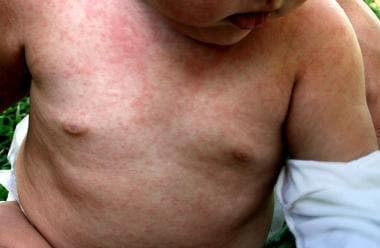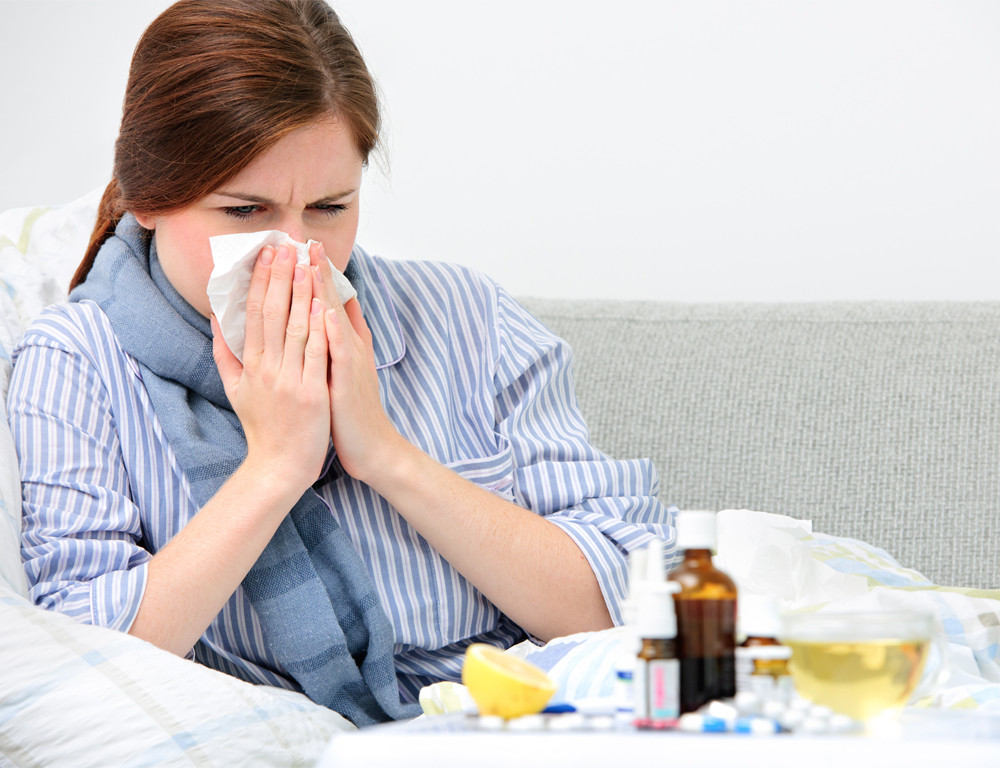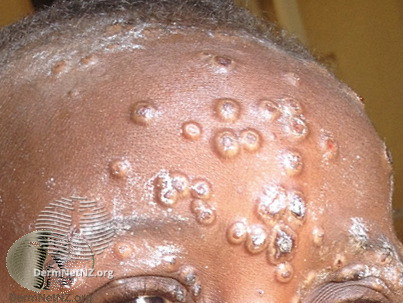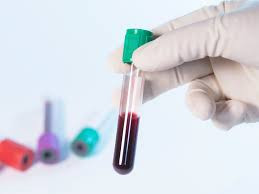Definition
Roseola is a viral infection frequently observed in children. It is also referred to as roseola infantum, exanthem subitum, and sixth disease. It predominantly affects infants and young children between the ages of 6 months and 2 years. Although rare, adults can contract roseola, particularly if they did not have the infection during childhood. Individuals with compromised immune systems may also experience reactivation of roseola infections. Generally, roseola is not considered a serious illness and typically resolves on its own over time.
The infection is usually characterized by a high fever followed by a distinctive rash of pink patches or bumps. This rash typically appears after the fever subsides, lasting approximately 3 to 5 days, and may cause the child to become irritable and feel unwell.
Causes
Human herpesvirus (HHV) infection is the cause of roseola. Roseola is primarily caused by the HHV-6, which can also occasionally result from an HHV-7 infection. Since humans are the only known natural host for HHV-6 and HHV-7, the virus will still be present in the child's body but typically latent (inactive).
Similar to other viral infectious diseases, contact with respiratory droplets or saliva from an infected individual can transmit roseola from one person to another. The HHV can be transmitted by coughing, sneezing, or close contact with an infected person. For instance, healthy children can get infected if they share a cup with an infected child. Roseola has an incubation period of 9-10 days following virus exposure.
Roseola can spread even in the absence of a rash. This implies that even before a child is officially diagnosed with roseola, the virus can still spread when they merely have a fever. A patient with roseola can still spread the virus even if they are asymptomatic. But by the time skin rash appears, which nearly often follows a fever, the illness is no longer contagious. Roseola can infect people at any time of year, however it rarely results in a widespread outbreak in the population.
Risk factor
Infants and toddlers—particularly those between six months and two years—are more likely to contract roseola. This is because infants and toddlers' immune systems are still developing and cannot yet develop antibodies to fight viral infections. Less than six months old babies could still have antibodies from their mother that they received while still in the uterus. However, the protective impact of the immune system will decrease as the baby gets older. Roseola is uncommon in adults since childhood infection might provide a lifetime immunity to the illness. Recurrence is possible, but it is quite uncommon. Adults experiencing recurrent roseola typically have compromised immune systems, such as individuals on chemotherapy or HIV/AIDS patients.
Symptoms
Suppose a child is exposed to someone with roseola and becomes infected with the human herpes virus (HHV). In that case, the incubation period is typically one to two weeks before signs and symptoms appear. In some cases, individuals with roseola may be asymptomatic, or the infection may present only mild symptoms. Symptoms of roseola can include:
- Fever
Roseola often begins with a sudden high fever, frequently exceeding 39.4°C. Some children may also experience sore throat, runny nose, or cough in conjunction with or preceding the fever. Additionally, the child may have swollen lymph nodes in the neck. The fever usually persists for three to five days.
- Rash
After the fever subsides, a rash may appear, although this is not always the case. The rash consists of numerous small pink spots or patches, which are generally flat but may be slightly raised in some areas. Occasionally, a white ring surrounds some of the rash. The rash typically starts on the chest, back, and abdomen, spreading to the neck and arms, and in some cases, reaching the legs and face. This rash does not cause itchiness and generally lasts several hours to a few days before fading.
- Babies and toddlers may become irritable
- Mild diarrhea
- Lack of appetite
- Swollen eyelids
Diagnosis
The doctor will start with the child's parents or other primary caregivers to diagnose roseola. Your medical history, including past illnesses and treatment histories, will be discussed with the doctor, along with the symptoms you've experienced when they started and the location of the rash. The doctor will then conduct a physical examination. The doctor may use a thermometer to take the child's body temperature and may inspect the rash on the skin. The rash could also be palpated. Due to the very common clinical appearance of roseola, which involves a high fever followed by a rash appearance after the fever subsides, the diagnosis of roseola may be determined based on the symptoms and findings from physical examinations. In some cases, diagnostic tests could be ordered to aid in establishing the diagnosis of roseola. Although these tests are rarely requested, diagnostic tests like PCR (Polymerase Chain Reaction) or blood tests to measure antibody levels against the HHV may be performed.
Management
As with other viral infections, roseola typically resolves on its own without the need for special treatment. Antibiotics are not recommended for viral infections. Several treatment options focus on alleviating symptoms:
- Antipyretic drugs. Medications such as paracetamol or ibuprofen, approved for use in infants and children at lower doses than adults, can be purchased over the counter to help reduce fever and relieve discomfort.
- Adequate hydration and nutrition. Good hydration and adequate nutrition are crucial in managing viral infections like roseola. Ensure that you or your child drink plenty of water, as dehydration can be a side effect of high fever and may lead to seizures in children.
- Wearing cool, sweat-absorbing clothes can help prevent the rise of temperature in the body.
- Bathing your child with warm water can help them relax and feel more comfortable.
Complications
Roseola can cause febrile seizures in approximately 15 percent of infected children due to high fever. Signs of a febrile seizure include twitching or jerking movements, altered consciousness, and rolling of the eyes. Though rare, roseola can lead to other serious health complications, such as:
- Encephalitis (inflammation of brain tissue)
- Pneumonia (lung infection)
- Meningitis (inflammation of the membranes or meninges surrounding the brain and spinal cord)
- Hepatitis (inflammation of the liver, often caused by a virus)
- Myocarditis (inflammation of the heart muscle)
- Rhabdomyolysis (breakdown of muscle tissue which releases harmful proteins into the bloodstream)
- Thrombocytopenia (low blood platelet count)
- Guillain-Barré syndrome (an autoimmune disorder that attacks the nervous system)
Prevention
Currently, there is no vaccine available to prevent roseola infection. Therefore, the best preventive measure is avoiding exposure to infected individuals. Given that roseola primarily affects young children, the following steps can help reduce the risk of infection:
- Keep children at home if they are feeling unwell
- Family members should wash their hands frequently
- Teach children to use tissues to cover their face when they cough or sneeze and to wash their hands afterward or to cough and sneeze into their elbow
- Avoid sharing cups or utensils with others and encourage children to do the same
- Regularly clean and disinfect commonly touched surfaces, such as doorknobs and railings
- Frequently clean and disinfect toys
When to see a doctor?
Consult a doctor for your child if:
- Your child's fever exceeds 39.4°C
- Your child has roseola, and the fever persists for more than seven days
- The rash does not improve after three days
In some cases, the high fever associated with roseola can cause febrile seizures. If your child experiences a seizure, seek immediate medical attention by visiting the emergency room.
Looking for more information about other diseases? Click here!
- dr Nadia Opmalina
Gardner, Stephanie S. What Is Roseola?. (2021). Retrieved 29 April 2022, from https://www.webmd.com/skin-problems-and-treatments/what-is-roseola
Leonard, Jayne. What You Should Know About Roseola. (2017). Retrieved 29 April 2022, from https://www.medicalnewstoday.com/articles/320357
Marks, Julie, et al. Roseola (Sixth Disease): Symptoms, Treatment, and More. (2022). Retrieved 29 April 2022, from https://www.healthline.com/health/roseola
Mersch, John. Roseola. Retrieved 29 April 2022, from https://www.medicinenet.com/roseola/article.htm
Roseola. (2020). Retrieved 29 April 2022, from https://www.mayoclinic.org/diseases-conditions/roseola/symptoms-causes/syc-20377283
Roseola. (2020). Retrieved 29 April 2022, from https://my.clevelandclinic.org/health/diseases/15785-roseola-infantumsixth-disease
Tesini, Brenda L. Roseola Infatum. (2021). Retrieved 29 April 2022, from https://www.msdmanuals.com/home/children-s-health-issues/viral-infections-in-infants-and-children/roseola-infantum












